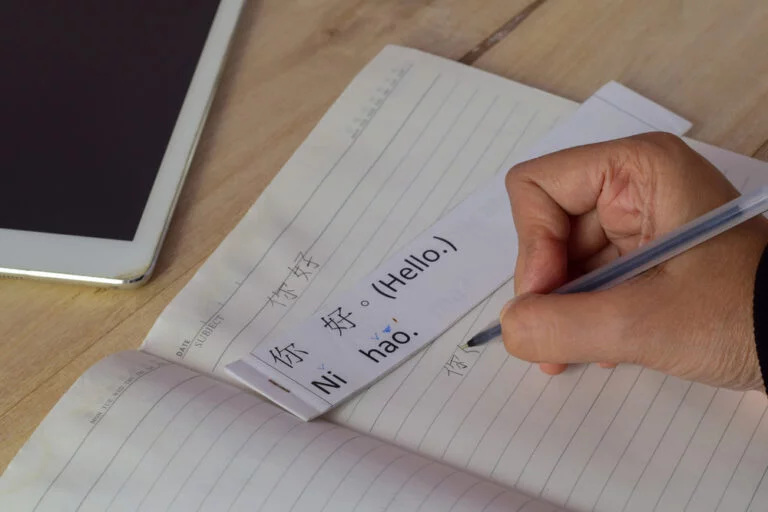Chinese Tone Pairs: The Top 5 Most Difficult

In Mandarin Chinese, combining the 4 Mandarin tones in different patterns can create tricky pronunciation challenges. Certain Chinese tone pairs tend to trip learners up more than others. In this post, we’ll go over 5 of the most difficult Chinese tone pairs and how to pronounce them properly.
You can also check out our video and start getting used to the sounds of even the most difficult Chinese tone pairs.
The intricacies of connecting Chinese tones
First, let’s understand why certain combinations of tones in Chinese pose problems. In English, we don’t have nearly as many tonal variations in syllables. But in Mandarin, the intricate tonal patterns carry lexical meaning and must be pronounced precisely. Mandarin Chinese, as well as some other languages such as Punjabi and Cherokee, are considered “tonal language.”
When two syllables with contrasting pitch contours come together, it can be hard for an English speaker’s ears and vocal cords to replicate those sounds accurately. The unfamiliar tonal acrobatics trip us up.
But with focused practice, you can train your mouth and ears to handle even difficult Chinese tone pairs fluidly. Knowing which combinations tend to be tricky will help you identify problem areas to work on.
Related Reading: 4 Mandarin Tones
1. The 1-4 tone pair: A leap from level to decline
Topping our list of challenging combinations is the 1st tone, followed by the 4th. The very structure of this pair is unique, especially when juxtaposed with English tonal patterns.
One word that encapsulates this Chinese tone pair is “知道” (zhīdào), which translates to “to know.” The key here is the assertiveness of the 4th tone, a rapid decline not often found in English speech patterns.
A common hiccup here is the inclination to change the steady 1st tone to a rising 2nd tone. Consistent practice with this pair will help cement its unique sound in your mind.
Related Reading: The Sounds of Mandarin Chinese
2. The 4-1 tone pair: A tonal roller coaster
Think of this as the inverse journey of the 1-4 tone pair. “在家” (zàijiā), or “at home,” is an excellent illustration. It begins with a decisive drop (4th tone) and then transitions into the flat terrain of the 1st tone. The challenge lies in ensuring a clear distinction between the two opposing tones.
Many learners tend to shorten the 4th tone too much in an effort to ease the transition. But keeping the 4th tone crisp and assertive is crucial. Don’t let the pitch drop gradually — it should plummet down steeply to establish its signature falling contour.
At the same time, hold the 1st tone steady and level, resisting the urge to let it rise up. Drawing a clear contrast between the plunging 4th tone and the flat 1st tone may feel unnatural at first. But with practice, you can train your vocal cords to make this dramatic transition smoothly.
Given its opposing zigzag nature, this 4th tone to 1st tone pairing is one of those Mandarin tones that demands conscious practice. Isolate words like “zàijiā” and repeatedly say them slowly, then faster.
Mimic audio recordings focusing on nailing the tone shapes. Record yourself to check that you fully commit to the fall and flatten without blurring the tones. With time and repetition, even this tricky tone change will start to feel more intuitive.
Related Reading: Tone Change Rules In Mandarin Chinese

3. The 3-2 tone pair: The subtle dip and rise
Among the Mandarin tones, the 3-2 tone pair has its own charm. Yet, it’s also where many students falter. “有钱” (yǒuqián) meaning “wealthy,” encapsulates this tonal shift between two of the Chinese tones. It’s not uncommon for learners to inadvertently switch these tones due to their changing pitch contours.
To conquer this challenging pairing of Chinese tones, emphasize the 3rd tone’s dip and ensure it doesn’t morph into the rising shape of the 2nd tone. The key is to start low and make the swoop downwards very obvious. Keep it brief without letting the pitch rise up at the end.
Then, transition smoothly into the 2nd tone, letting the pitch glide upwards. Avoid starting the pitch rise too early. Keep the distinction clear between the falling Chinese 3rd tone and the rising Chinese 2nd tone.
Isolate 3-2 pairings and repeat them slowly. Gradually increase the speed with practice. Record yourself to ensure you fully commit to the drop before letting the pitch curve upwards. With time, even tricky Chinese tone pairs like 3-2 will start to feel more natural.
Related Reading: The Hardest Sounds in Chinese…Until Now!

4. The 2-3 tone pair: Climbing and descending
Many beginners are often surprised that they’re mispronouncing a simple greeting like “你好” (níhǎo) or “hello.” The secret lies in perfectly executing the intricate tonal balance between two of the mandarin tones.
The key is to emphasize the upward motion of the rising Chinese 2nd tone and ensure the distinction from the gentle descent of the Chinese 3rd tone is crystal clear. Don’t cut the 2nd tone short. Let the pitch glide smoothly upwards to the high point without dropping early into the 3rd tone.
A common mistake is not raising the 2nd tone pitch high enough before transitioning into the swooping Chinese 3rd tone. Really exaggerate that upward slope and high point to establish the contour of the Chinese 2nd tone.
Isolate the 2-3 tone pairing and repeat it slowly. Gradually increase the speed with practice. Soon, this tricky combination of Chinese tones will start to feel natural. With mastery, you’ll never mispronounce common greetings due to problematic Chinese tone pairs again!
Related Reading: Best Resources for Learning Chinese
5. The 3-4 tone pair: From low to assertive
The final pairing in our lineup of tricky Mandarin tones, the 3-4 tone combination, can be seen in words like “可乐” (kělè) or “cola.” The rhythm and precision of this tonal dance is crucial.
The Chinese 3rd tone should be executed briefly and deeply, using that signature zombie groan contour we’ve emphasized. Don’t let the pitch rise up at the end of the 3rd tone.
In contrast, pronounce the Chinese 4th tone very forcefully, letting the pitch plummet down sharply. This assertive falling shape gives the 4th tone its distinctive tone.
With this problematic pairing of Chinese tones, there’s no room for hesitation or gradual transitions between the tones. The distinction must be clear and precise. Exaggerate the croak of the 3rd tone and the fall of the 4th tone.
Isolate 3-4 pairings and repeat them slowly, then faster. Soon, these difficult Chinese tones will flow smoothly together in natural speech. Your precision will pay off in mastery of even tricky Mandarin tone combinations.
Strategies for Mastering Challenging Tone Pairs
Here are some tips for getting problematic Chinese tone pairs under control:
- Isolate tone pairs and say them slowly, then speed up with practice
- Mimic audio recordings of native speakers saying tricky words
- Try learning some Chinese tongue twisters!
- Mark pinyin tones for words you struggle with to check pronunciation
- Make flashcards for difficult tone pair combinations to drill regularly
- Record yourself and listen back critically, focusing on smoothing tone transitions.
With regular practice, your brain will learn to switch between even tricky Chinese tone pairs smoothly. Be patient in the process — you’ll get those difficult Mandarin tones in time!
Related Reading: The Ultimate Guide to Learning Chinese Online
Want to discover more secrets to rapid Mandarin fluency?
Struggling with tricky Mandarin tone combinations? What if you could discover shortcuts to smooth, natural pronunciation?
Join our free webinar to learn the insider techniques that allow you to master even difficult Chinese tone pairs quickly and intuitively.
In this webinar, you’ll discover:
- Hidden pronunciation patterns in tone combinations
- Easy memorization tips for tricky words
- How to retrain your mouth and ears for fluid tones
- The #1 obstacle learners face with tones and how to overcome it.
Don’t let tricky tones slow you down. Register now to get instant access to the secrets that make even difficult Mandarin pronunciation easy!







